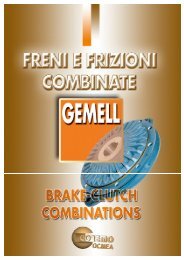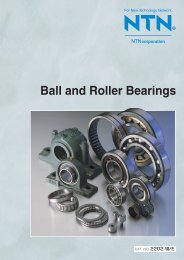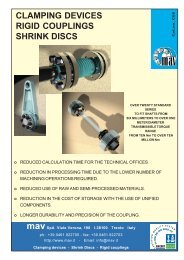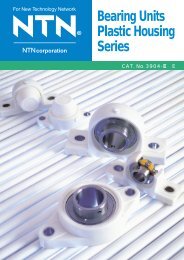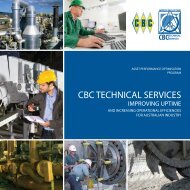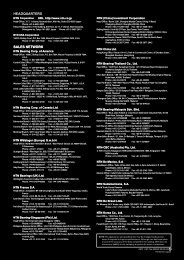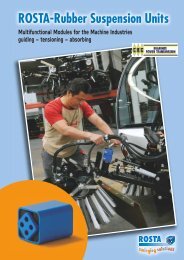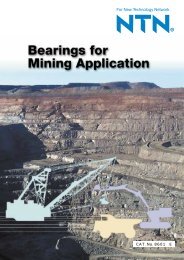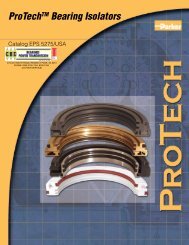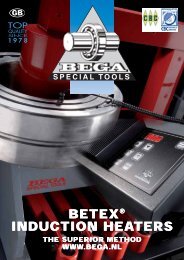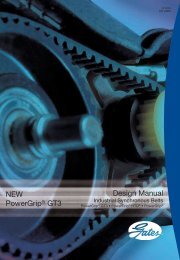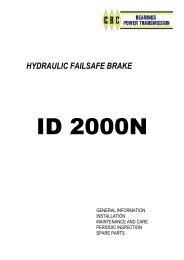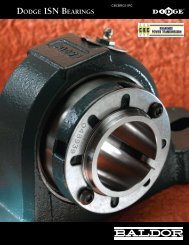Needle Roller Bearings - Ntn-snr.com
Needle Roller Bearings - Ntn-snr.com
Needle Roller Bearings - Ntn-snr.com
You also want an ePaper? Increase the reach of your titles
YUMPU automatically turns print PDFs into web optimized ePapers that Google loves.
Lubrication<br />
NTN<br />
Table 8.2 Grease varieties and characteristics<br />
Grease name<br />
Lithium grease<br />
Sodium grease<br />
(Fiber grease)<br />
Calcium<br />
<strong>com</strong>pound base<br />
grease<br />
Aluminum<br />
grease<br />
Non-soap grease<br />
Thickener<br />
Ca+Na soap<br />
Li soap Na soap Al soap<br />
Ca+Li soap<br />
Bentone, silica gel, urea,<br />
carbon black, etc.<br />
Base oil<br />
Mineral oil<br />
Dropping point ˚C 170190<br />
Operating<br />
temperature range ˚C 30130<br />
Mechanical stability Excellent<br />
Pressure resistance Good<br />
Water resistance Good<br />
Broadest<br />
application.<br />
Applications<br />
Grease for<br />
universal type<br />
rolling bearings.<br />
Diester oil<br />
170190<br />
50130<br />
Good<br />
Good<br />
Good<br />
Excellent in low<br />
temperature<br />
characteristic and<br />
anti-friction<br />
characteristic.<br />
Silicone oil<br />
200250<br />
50160<br />
Good<br />
Poor<br />
Good<br />
suited to high<br />
temperature and<br />
low temperature.<br />
Low oil film<br />
strength and<br />
unsuitable for<br />
high load<br />
application.<br />
Mineral oil<br />
150180<br />
20130<br />
Excellent to good<br />
Good<br />
Good to poor<br />
emulsified by<br />
inclusion of water<br />
content.<br />
Comparatively<br />
excellent in high<br />
temperature<br />
characteristic.<br />
Mineral oil<br />
150180<br />
20120<br />
Excellent to good<br />
Excellent to good<br />
Good to poor<br />
Excellent in water<br />
resistance and<br />
mechanical<br />
stability.<br />
Suitable for<br />
bearing subjected<br />
to shock load.<br />
Mineral oil<br />
7090<br />
1080<br />
Good to poor<br />
Good<br />
Good<br />
Excellent in<br />
viscosity<br />
characteristic.<br />
Suitable for<br />
bearing subjected<br />
to vibration.<br />
Mineral oil<br />
250 or more<br />
10130<br />
Good<br />
Good<br />
Good<br />
Synthetic oil<br />
250 or more<br />
50200<br />
Good<br />
Good<br />
Good<br />
Available for use in wide temperature<br />
range from low to high temperature.<br />
Some of non-soap base greases are<br />
excellent in heat resistance, cold<br />
resistance, chemical resistance, etc.<br />
subject to proper <strong>com</strong>bination of base<br />
oil and thickener.<br />
Grease for universal type rolling<br />
bearings.<br />
Remarks: The operating temperature range in this table is the general characteristic value, not the guaranteed value.<br />
8.1.4 Additives<br />
Any greases contain various additives to improve the<br />
performance, for example, containing oxidation inhibitor,<br />
extreme pressure additives (EP additives), rust inhibitor,<br />
corrosion inhibitor, etc.<br />
A grease containing extreme pressure additives is used<br />
for bearings subjected to high load or shock load. A<br />
grease containing oxidation stabilizer is used for bearing<br />
applications wherein the operating temperature is<br />
<strong>com</strong>paratively high and no grease is replenished for a<br />
long time.<br />
8.1.5 Consistency<br />
"Consistency" is an index showing the hardness or<br />
fluidity of grease. The greater numerical value thereof is<br />
the softer hardness. This consistency is determined by<br />
the amount of thickener and the viscosity of base oil.<br />
Usually NLGI consistency codes 1 and 2 or 3 are used for<br />
lubrication of bearings.<br />
Table 8.3 shows the general relationship of grease<br />
consistency to application.<br />
8.1.6 Grease mixing<br />
When different greases are mixed together, the<br />
consistency of the mixed grease varies (generally<br />
softens) so that the allowable operating temperature gets<br />
lower. To avoid such characteristic variation of grease, it<br />
is not allowed to mix different greases, except mixing<br />
greases of same brand.<br />
Where mixing of different greases is inevitable, greases<br />
<strong>com</strong>posed of thickener of same kind and similar base oil must<br />
be selected. Even when greases of same kind are mixed<br />
together, thus, the properties of the mixed grease could vary<br />
depending on difference in additives, etc. It is therefore<br />
necessary to check the property variation in advance.<br />
Table 8.3 Grease consistency<br />
NLGI<br />
consistency No.<br />
0<br />
1<br />
2<br />
3<br />
4<br />
Soft<br />
Hard<br />
JIS (ASTM)<br />
60-cycle mixed<br />
grease consistency<br />
355385<br />
310340<br />
265295<br />
220250<br />
175205<br />
Application<br />
For centralized greasing<br />
For centralized greasing<br />
For general application, for tight-sealed bearing<br />
For general application, for high temperature<br />
Special application<br />
8.1.7 Grease fill amount<br />
Grease fill amount differs depending on housing<br />
design, spacing volume, rotational speed, kind of grease,<br />
etc.<br />
Around 50% to 80% of static spacing volume in bearing<br />
and housing is deemed as a guideline to the fill amount.<br />
In the case of high rotational speed, this fill amount must<br />
be set up a little bit less for controlling temperature rise to<br />
a low rate. Too much fill amount of grease would<br />
cause the grease temperature to rise higher, which<br />
would then lead to reduction of the specific<br />
lubrication performance due to leak of the softened<br />
grease or quality change such as oxidation, etc.<br />
Further, for the machined ring needle roller bearing with<br />
inner ring the approximate value of spacing volume in the<br />
bearing can be determined by formula (8.1).<br />
V35W ⋯⋯⋯⋯⋯⋯⋯⋯⋯⋯⋯⋯⋯⋯⋯⋯(8.1)<br />
where,<br />
V : Internal spacing volume (approximate value) cm 3<br />
W : Bearing weight kg (See Dimensions Table)<br />
A-41




